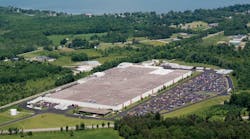LAKEWOOD, NY. In perhaps something of an unusual twist, global engine maker Cummins Inc. is celebrating the 40th anniversary of its Jamestown Engine Plant this week even though the factory– which builds primarily on-highway engines-– is not actually located in Jamestown, NY.
Instead, it’s nestled in the nearby village of Lakewood, a bucolic hamlet that sits a stone’s throw away from Pennsylvania to the south and Lake Erie to the west.
Cummins said more than 400 engines are now built per day at its Jamestown plant, which employs some 1,500 and produced its 1.5 millionth heavy-duty engine in the summer of last year.
The OEM originally acquired the more than one-million-sq-ft facility in 1974, using it initially to manufacture engine components before gradually shifting to complete engine units in 1979.
In 2002, the company initiated a massive transfer of its on-highway engine production operations from Columbus, IN, which also serves as its global headquarters, to the Jamestown plant – a move that shifted 250 jobs to the Jamestown factory.
Today, the Jamestown facility builds all of Cummins’ on-highway engines, including the ISX15, the ISX12 and ISM diesel engines, along with the Cummins Westport ISX12 G spark-ignited natural gas engine. The ISX15 and ISX12 engines both serve the U.S. and Canadian markets, noted the OEM, while the ISM is currently exported to Mexico, the OEM noted.
The factory also produces the QSM and QSX engines that serve off-highway customers in construction, agriculture and marine applications.
In another historical footnote, the transfer of Cummins’ engine building operations to Jamestown occurred roughly around the time the OEM introduced the “IS” and “QS” designations to differentiate its engine product segments.
Standing for “Interact Systems” and “Quantum Systems,” respectively, the IS and QS acronyms are monikers designed to represent the company’s shift to electronically-controlled engine platforms, which occurred in the late 1990s, and thus to replace its old single-letter identifiers. Thus the “M11” engine became an “ISM” engine in highway service or a “QSM” in off-road or marine applications.
It’s also interesting to note that shifting engine manufacturing to Jamestown in 2002 marked the beginning of a significant period of growth for Cummins as its global sales increased from $5.7 billion in 2001 to over $17.3 billion as of 2013.
In the second quarter of 2014 alone, Cummins generated revenue of $4.8 billion – a mere $900 million short of its entire annual revenue 12 years ago – which represents an increase of 7% from the same quarter in 2013 due to stronger demand in on-highway markets and distributor acquisitions in North America.
Cummins added that second quarter revenues in North America increased 14% while international sales decreased 1% percent compared to the second quarter in 2013, with lower revenues in Mexico, Brazil and India offset stronger demand in China.
"Demand is growing in on-highway markets in North America this year as the economy improves and we have gained market share in medium duty truck and bus markets,” noted Cummins Chairman and CEO Tom Linebarger in a statement, adding that, based on the company’s current forecast, the OEM expects its full year 2014 revenues to grow between 8% and 11%, up from its previous forecast of growth of between 6% and 10%, due largely to improving demand in North America.



